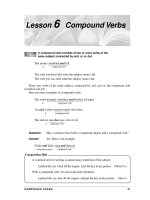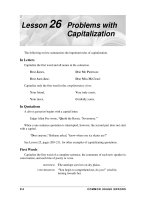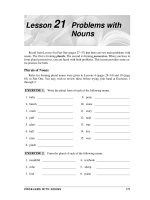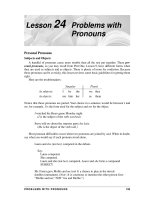Grammar And Usage For Better Writing - Compound Verbs
Bạn đang xem bản rút gọn của tài liệu. Xem và tải ngay bản đầy đủ của tài liệu tại đây (50.9 KB, 20 trang )
COMPOUND VERBS 41
A compound verb consists of two or more verbs of the
same subject connected by and, or, or but.
The runner
S. compound verb
The verb stumbled tells what the subject runner did.
The verb fell, too, tells what the subject runner did.
These two verbs of the same subject, connected by and, give us the compound verb
stumbled and fell.
Here are more examples of compound verbs:
The wind all night.
S. compound verb
At night I often television.
S. compound verb
The old car a lot of oil.
S. compound verb
Question:
May a sentence have both a compound subject and a compound verb?
Answer:
Yes. Here is an example:
Cindy and Luke
compound subject compound verb
sang and danced.
runs but uses
read or watch
moaned, whistled, and howled
stumbled and fell.
Composition Hint
A common error in writing is unnecessary repetition of the subject.
I parked the car. I shut off the engine. I put the key in my pocket. (Three I’s.)
With a compound verb, we can avoid such repetition.
I parked the car, shut off the engine, and put the key in my pocket. (One I.)
Lesson
6
Compound Verbs
EXERCISE 1.
Eliminate repetition of the subject by using a compound verb.
Samples:
She jogs.
She swims.
She plays tennis.
We tried.
We did not succeed.
Note:
When a compound verb consists of more than two parts, put a comma after each
part, except the last:
jogs, swims, and plays . . .
1. Fire endangers life.
Fire destroys property.
2. I went in.
I took one look.
I left.
3. A teacher explains the subject.
A teacher tests students.
4. They have money.
They do not know how to spend it.
5. Should we leave?
Should we wait a little bit longer?
6. We closed the windows.
We turned off the lights.
We locked the door.
7. A good book holds your interest.
A good book teaches you something.
8. He ordered a grilled cheese sandwich.
He left it untouched.
9. The lungs provide the blood with oxygen.
The lungs remove carbon dioxide.
We tried but did not succeed.
tennis.
She jogs, swims, and plays
42 PARTS OF SPEECH
10. She borrowed my notes.
She did not return them.
Read the following passage. (Sentences have been numbered.)
1
James and Benjamin Franklin were brothers.
2
They lived and worked
in Boston in colonial America.
3
James, the older, operated a printing shop.
4
He employed Benjamin and taught him the printing trade.
5
Often, how-
ever, they quarreled and came to blows.
6
Finally, in 1723, Benjamin ran
away.
7
Benjamin arrived in Philadelphia, tired and hungry.
8
He saw a boy eat-
ing bread and struck up a conversation.
9
The boy gave Benjamin directions
to a baker’s shop.
10
Benjamin went there, ordered three pennies’ worth of
bread, and received three enormous loaves.
11
Their size astounded him.
12
Evidently, bread was much cheaper in Philadelphia than in Boston.
13
Eating one loaf, Benjamin walked the streets of Philadelphia with an-
other loaf under each arm.
14
He must have looked ridiculous.
15
Deborah
Read saw him and laughed.
16
Seven years later, Deborah and Benjamin
would become man and wife.
EXERCISE 2.
Below, write the subject and the verb of each sentence in the passage
you have just read. Caution: Some of the subjects are compound, and some of the verbs
are compound. The subject and the verb of the first two sentences have been filled in for
you as samples.
SUBJECT VERB
1.
2.
3.
4.
5.
6.
7.
8.
9.
10.
lived and workedThey
wereJames and Benjamin Franklin
COMPOUND VERBS 43
SUBJECT VERB
11.
12.
13.
14.
15.
16.
44 PARTS OF SPEECH
Lesson
7
Nouns as
Direct Objects
NOUNS AS DIRECT OBJECTS 45
How is the noun Amy used in these two sentences?
1. Amy is our top scorer.
2. The crowd cheered Amy.
In the first sentence, the noun Amy is the subject of the verb is. In the second sentence, the
noun Amy is the direct object of the verb cheered.
What Is a Direct Object?
A direct object is a word in the predicate that receives the
action of the verb.
In sentence 2, above, the noun Amy is the word in the predicate that receives the action
of the verb cheered. Therefore, the noun Amy is the direct object of the verb cheered.
Note:
There can be no direct object without an action verb.
Compare the noun Amy in the following sentences:
1. Our top scorer is Amy.
2. The crowd cheered Amy.
Sentence 1 cannot have a direct object because it has no action verb; is does not ex-
press action. Amy, in sentence 1, is not a direct object.
On the other hand, sentence 2 can have a direct object because it has an action verb;
cheered expresses action. Amy, in sentence 2, receives the action of the verb cheered and is
a direct object of that verb.
The crowd cheered Amy.
S. V. D.O.
Question:
Are there other verbs, besides is, that do not express action?
Answer:
Yes. Here are some of them:
am will be may be have been
are shall be might be has been
was would be can be had been
were should be could be will have been
All of the listed verbs, including is, are forms of a single verb—the verb be.
Remember the following about am, is, are, will be, and all other forms of the verb be:
1. They do not express action.
2. They cannot have a direct object.
EXERCISE 1.
In which sentence, a or b, is the italicized noun a direct object? Write
the letters D.O. on the proper line.
Sample:
a. Paul and Donna are my cousins. a.
b. I called my cousins. b.
1. a. Stephen Crane was a reporter. a.
b. The publisher dismissed the reporter. b.
2. a. Ginette plays two stringed instruments. a.
b. The violin, guitar, and cello are stringed instruments. b.
3. a. Mercedes has been president since April. a.
b. The members are blaming the president. b.
4. a. For years Dr. Kroll had been our dentist. a.
b. We have found a new dentist. b.
5. a. Mr. Reed is Jean’s teacher. a.
b. The district has hired a new art teacher. b.
Easy Procedure for Finding the Direct Object
To find the direct object, ask the question WHAT? or WHOM? right after the action verb.
Question 1:
What is the direct object in the following sentence?
Caroline drives a Ford.
Procedure:
Caroline drives a WHAT?
Answer:
Ford is the direct object.
Question 2:
What is the direct object in the following?
I watched the artist at work.
Procedure:
I watched WHOM at work?
Answer:
Artist is the direct object.
D.O.
46 PARTS OF SPEECH
Note that a direct object may be compound: It may consist of more than one word.
The following sentence has a compound direct object:
Heavy rain flooded the streets and highways.
S. V. compound direct object
EXERCISE 2.
In each sentence below, find the verb (V.), the subject (S.), and the di-
rect object (D.O.).
Samples:
Water loosens the soil. V.
S.
D.O.
The team has already left. V.
S.
D.O.
1. The speaker’s question surprised V.
and amused the audience.
S.
D.O.
2. Have some yogurt and fruit. V.
S.
D.O.
3. Are the snow and ice melting? V.
S.
D.O.
4. The World Wide Web and television V.
provide information and entertainment.
S.
D.O.
5. Jonathan returned the books to the library. V.
S.
D.O.
none
team
has left
soil
Water
loosens
NOUNS AS DIRECT OBJECTS 47
Lesson
8
Nouns as
Indirect Objects
48 PARTS OF SPEECH
How is the noun Amy used in the following sentence?
The crowd gave Amy a cheer.
S. V. ? D.O.
Amy is the indirect object of the verb gave.
What Is an Indirect Object?
An indirect object is a word in the predicate that tells FOR
WHOM or TO WHOM something was done, or is being done,
or will be done.
Note that there are two nouns after the action verb gave: Amy and cheer. The noun
cheer is the direct object of gave because it answers the question WHAT? (The crowd gave
WHAT?) The noun Amy tells FOR WHOM the crowd gave a cheer. Therefore, Amy is the
indirect object of the verb gave.
The crowd gave Amy a cheer.
S. V. I.O. D.O.
The above sentence shows that an action verb can have both a direct object and an
indirect object in the same sentence.
Question:
Which comes first in a sentence, the direct object or the indirect
object?
Answer:
The indirect object always comes before the direct object. Note these
further examples:
A friend sent Marilyn a card.
I.O. D.O.
(Marilyn is the indirect object because it tells TO WHOM a friend sent
a card.)









